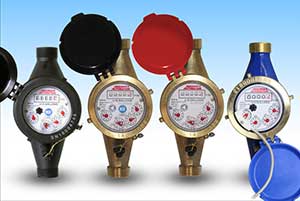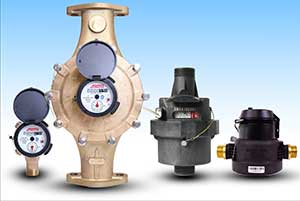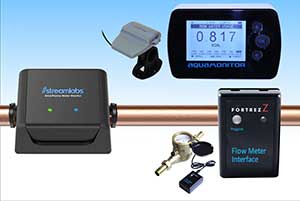Home and Apartment Water Meters and Sub-meters
Multi-Jet Water Meters
 Multi-Jet water meters are the most common type of meters used in residential and commercial sub-metering applications. The time-tested working principle provides great accuracy and a wide flow range that maintains that degree of accuracy.
Multi-Jet water meters are the most common type of meters used in residential and commercial sub-metering applications. The time-tested working principle provides great accuracy and a wide flow range that maintains that degree of accuracy.
They must be installed horizontally with the register facing directly upwards in order to maintain accuracy. These meters all come with Union NPT male fittings that make positioning and removal simple.
Pulse output is available on most with a few rates to choose from on many. This allows the addition of a digital display for remote viewing and, if desired, the ability to reset to 0.
NSF Approved for Drinking Water (Lead Free)
Not NSF Approved
Positive Displacement Water Meters
 Positive Displacement meters offer the convenience of being accurate in any orientation. There are 2 different types of positive displacement meters offered by Flows.com: Nutating disc and Piston.
Positive Displacement meters offer the convenience of being accurate in any orientation. There are 2 different types of positive displacement meters offered by Flows.com: Nutating disc and Piston.
Nutating disc meters are also commonly used as residential water meters. They look very similar to a multi-jet meter on the outside, but the internals are completely different. The popular Neptune T10 is of this type, but it does not offer a pulse output option.
Piston type positive displacement meters are yet another completely different internal design. They are great for low flow rates. Pulse output is available on both series of this type. 1 pulse per gallon or 20 pulses per gallon.
NSF Approved for Drinking Water (Lead Free)
"Smart Home" Water Meters
 Homes keep getting smarter and smarter. These meters will add your water usage to what it knows. These "Smart Home" water meters will allow you to access your water usage data either online or using a mobile app. They feature usage logging, graphical views of the data, leak & freeze alerts, automatic reporting, etc.
Homes keep getting smarter and smarter. These meters will add your water usage to what it knows. These "Smart Home" water meters will allow you to access your water usage data either online or using a mobile app. They feature usage logging, graphical views of the data, leak & freeze alerts, automatic reporting, etc.
Wireless Smart Meters
Z-wave & SmartThings
There are many reasons that homeowners, landlords, tenants, and business owners would want to install additional water meters into the plumbing systems of their home, business, or apartment building. Regardless of the reason, Flows.com has the right meter and the expertise to help you select which meter is the best for your installation.
Homeowners
- to verify the accuracy of the utility company or municipal water meter
- to tally 'non-sewage' use of water for deduction from sewage bill (deduct meter)
- to add a remote digital display for simplified reading and the ability to easily reset to 0
- to tally the amount of HOT water used
- to increase awareness of water consumption and assist in conservation efforts
- to detect leaks
- to sub-meter or measure usage from a certain portion of the residence (laundry, lawn & garden, etc.)
Landlords and Property Managers
- to sub-meter individual units that share a common utility meter
- to be able to read the meter without entering a tenant's property
- to detect leaks and avoid disputes over high water bills
- to use as a deduct meter for 'common use' water outlets like an outdoor spigot
- to verify the accuracy of the municipal water meter
- to use with a wireless remote reading system and access usage data online
A Few Things That You Should Know About Residential Water Meters
Orientation: Certain types of meters require a specific orientation to maintain accuracy.
Body Material: If using meters for drinking water, you must make sure that any brass or bronze is LEAD FREE. Depending on your local laws and regulations, you may be required to use only NSF certified meters. The WM-NLC, WM-PC, and D10 series are all NSF certified and have the certification logos clearly visible on the meters' faces.
Pulse Output: This is used to signal the passage of a certain amount of water to some sort of counter, digital display, wireless sub-metering system, or electronic controller. For more information on Pulse Output, see What is Pulse Output?
NPT/Union Connections: Most meters utilize "true union" connections which make rotating the meter to the proper orientation easy. This connection type also makes removal of the meter for maintenance or replacement easy. If water is needed to flow while the meter is out, we offer a spacer tube or "dummy meter" that can be put in place of the meter. The connections consist of a collar nut, flat ring seal, and an NPT pipe stub that is permanently connected to the pipe.
Check Valves: These valves allow flow in one direction only. It is always a good idea to use a check valve to prevent reverse flow through a meter.
Isolation Valves: These are simple shutoff valves. Typically a 2-way full port ball valve. By placing one of these before and after the meter, you can isolate that section of pipe, so that the meter can be removed for maintenance or replaced without having to turn off the main water supply, or drain all of the water downstream from the meter.
Bypass Lines: These use two 3-way ball valves and a length of pipe to create an alternate flow path that goes around the meter. This will allow letting water bypass the meter if that is ever desirable. Bypass valves should include locking devices to prevent use if not in a secured area. The 33D series is perfect for creating a bypass line.
Types of Residential Water Meters
Multi-Jet Sub-meters
These are the most commonly used and are familiar to most people. They look just like the meters used by the utility company. Due to the working principle used by these meters, they must be installed horizontally with the register facing directly upwards to maintain their accuracy. Flows.com offers a complete range of multi-jet water sub-meters from Assured Automation, as well as a Flexible Axis Meter from Master Meter which allows for the rotation of the register to any orientation regardless of the pipe orientation.
[ linked images and descriptions ]
Positive Displacement Sub-meters
The working principle of these meters allows them to be installed in any orientation. There are a two different styles of positive displacement meters from Assured Automation that are offered at Flows.com: Piston and Nutating Disc.
The D10 series use a nutating disc.
The WM-PD series uses a piston and is for low flow rates down to 6 Gallons per HOUR.
[ linked images and descriptions ]
